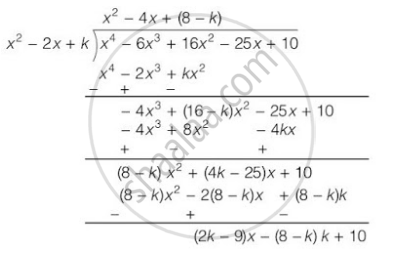Advertisements
Advertisements
प्रश्न
If the polynomial x4 – 6x3 + 16x2 – 25x + 10 is divided by another polynomial x2 – 2x + k, the remainder comes out to be x + a, find k and a.
उत्तर
On dividing x4 – 6x3 + 16x2 – 25x + 10 by x2 – 2x + k

∴ Remainder = (2k - 9)x - (8 - k)k + 10
But the remainder is given as x+ a.
On comparing their coefficients,
2k - 9 = 1
⇒ k = 10
⇒ k = 5 and,
-(8-k)k + 10 = a
⇒ a = -(8 - 5)5 + 10 =- 15 + 10 = -5
Hence, k = 5 and a = -5
APPEARS IN
संबंधित प्रश्न
Divide the polynomial p(x) by the polynomial g(x) and find the quotient and remainder in each of the following : p(x) = x4 – 3x2 + 4x + 5, g(x) = x2 + 1 – x
Apply division algorithm to find the quotient q(x) and remainder r(x) on dividing f(x) by g(x) in the following f(x) = 4x3 + 8x2 + 8x + 7, g(x) = 2x2 − x + 1
Find all zeros of the polynomial f(x) = 2x4 − 2x3 − 7x2 + 3x + 6, if its two zeros are `-sqrt(3/2)` and `sqrt(3/2)`
It is given that –1 is one of the zeroes of the polynomial `x^3 + 2x^2 – 11x – 12`. Find all the zeroes of the given polynomial.
State Division Algorithm for Polynomials.
Show that every positive odd integer is of the form (4q +1) or (4q+3), where q is some integer.
Find the quotient and remainder of the following.
(8y3 – 16y2 + 16y – 15) ÷ (2y – 1)
Find the quotient and remainder of the following.
(8x3 – 1) ÷ (2x – 1)
The base of a parallelogram is (5x + 4). Find its height if the area is 25x2 – 16
Can x2 – 1 be the quotient on division of x6 + 2x3 + x – 1 by a polynomial in x of degree 5?
